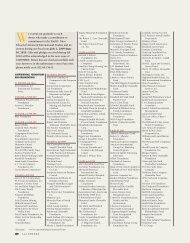Download Current Issue - SAIS
Download Current Issue - SAIS
Download Current Issue - SAIS
Create successful ePaper yourself
Turn your PDF publications into a flip-book with our unique Google optimized e-Paper software.
numbers are potentially catastrophic.<br />
Recall that a global average conceals<br />
uneven distribution spatially and over<br />
the seasons. W. Michael Haneman at<br />
the University of California, Berkeley,<br />
estimates that summertime temperatures<br />
in the agriculturally rich Central<br />
Valley in California would rise some<br />
2.5 times the global average. Using the<br />
upper bound of Sokolov’s estimate, this<br />
suggests a rise of 33.3 degrees Fahrenheit,<br />
far above catastrophic levels.<br />
Second, we also do not know what,<br />
if any, binding international agreements<br />
on mitigating greenhouse gas emissions<br />
will emerge following the termination<br />
of the Kyoto Protocol obligations in<br />
2012. The aspirational target of capping<br />
temperature rise to 2 degrees Celsius<br />
agreed to at the U.N. climate summit in<br />
Cancun, Mexico, last year is ambitious<br />
but has no legal force, does not reflect<br />
either a scientific or economic consensus,<br />
and—despite local initiatives—is<br />
unlikely to be achieved.<br />
Finally, we do not know whether<br />
productivity gains through agricultural<br />
research and development, and possible<br />
productivity gains from carbon fertilization,<br />
can offset production declines<br />
due to global warming. Declines can<br />
be anticipated even if not predicted<br />
with certainty. They will result from<br />
heat stress on plants, greater scarcity<br />
and seasonal variability of water for<br />
rain-fed and irrigated crops, and the<br />
loss of highly fertile delta and river bottomlands<br />
as sea levels rise and flooding<br />
increases. The challenge will be more<br />
difficult because world population and<br />
income growth are expected to double<br />
food demand during the first half of<br />
this century.<br />
In this fraught context, should promotion<br />
of biofuels be part of a green<br />
energy strategy?<br />
Dubious Subsidies and Mandates<br />
If one considers reducing greenhouse<br />
gas emissions and especially carbon<br />
dioxide as the centerpiece of climate<br />
policy, mandates requiring that biofuels<br />
be blended into transportation fuels<br />
appear superficially attractive. Fossil<br />
fuel takes carbon from under the earth,<br />
where it is harmless, burns it and emits<br />
Year of<br />
Agriculture<br />
at<strong>SAIS</strong><br />
that carbon as carbon dioxide to the<br />
atmosphere, where it is harmful. In<br />
contrast, biofuel crops extract carbon<br />
dioxide from the atmosphere during<br />
the growth phase and release carbon<br />
dioxide when they are burned or<br />
decompose. The goal with biofuels is to<br />
recycle carbon, not to add to the active<br />
stock. Let sleeping carbon lie.<br />
This simple idea has been taken up<br />
by many governments with perhaps<br />
more enthusiasm than good sense.<br />
Aside from cost, two major problems<br />
have emerged: indirect increases in<br />
carbon emissions via the conversion<br />
of land to biofuel crops, and pressures<br />
on food production and prices. To<br />
understand these problems, recall that<br />
biofuels come in three main flavors,<br />
depending on their feedstock: ethanol,<br />
made from sugars and starches (corn,<br />
sugarcane); biodiesel from fats and oils<br />
(palm oil, rapeseed, soy); and cellulosic<br />
ethanol from cellulose (woody material,<br />
grasses). The technology for the<br />
first two has been well established for<br />
decades, but except for sugar in Brazil,<br />
the costs are high and large subsidies<br />
are needed. Cellulosic technology is at<br />
an early stage.<br />
Biofuels do not float down from the<br />
heavens like manna. They or their feedstocks<br />
must be cultivated and harvested.<br />
Shifting land from its current status to<br />
biofuel feedstock production can initially<br />
increase carbon emissions from<br />
surface biomass (often by burning vegetation)<br />
and from carbon stored in soils.<br />
For example, clearing marginal land for<br />
corn and preparing the soil will result in<br />
a pulse of carbon emissions today.<br />
Readers inside the Washington<br />
Beltway may have seen the loss of<br />
scrub forest and loblolly pine and the<br />
expansion of soy and corn fields over<br />
the past 20 years as they traversed the<br />
Eastern Shore in their summer trek to<br />
Rehoboth, Delaware. This sort of land<br />
conversion creates a “carbon debt” that<br />
can be repaid over time by the carbonneutral<br />
crop (corn, sugarcane, soy)<br />
displacing the use of fossil fuels. The<br />
debt and timescale can be significant,<br />
however, and lie at the heart of allegations<br />
that biofuels accelerate rather<br />
than moderate global warming.<br />
2011–2012 45



